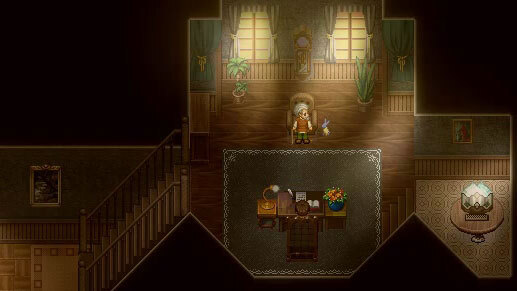This review was written before I started this blog and imported later for posterity.
Freebird Games’s To the Moon is a short (playable from start to finish in a few hours), story-based affair about an agency that grants the life-altering wishes of dying people by entering and altering their memories, so that they can pass on without regrets. It’s the first episode in a planned series and focuses on agents Watts and Rosalene’s quest to grant their client Johnny’s wish to go to the moon by planting the desire to do so deep in his childhood memories, Inception-style. The only problem is that Johnny has no idea why he wants to go to the moon in the first place.
Over the course of the game, Watts and Rosalene travel backwards through Johnny’s memories, slowly uncovering more and more about his life story, and eventually discovering the true, deeply buried motive behind his dying wish.
# Story & gameplay
This game is all about the story. It’s not going to draw you in with innovative game mechanics, or addictive Skinner Box-ey rising numbers, or mindblowing visual splendour. Although its website describes it as an “indie adventure RPG”, there’s really not any RPG here. People play and recommend To the Moon to others because of its story.
And I am very much more then okay with that. This review is garishly coloured by the rainbow of my enormous bias toward liking games that are all about story. I have terrible reflexes, no great competitive spirit, and the kind of creativity usually better suited to a game development program or a text processor than something like Minecraft (though I still enjoy a bit of that sort of game every now and then). I read books long before I touched my first computer game. I am unapologetically a fan of games more about story than gameplay, and I think it’s only fair to state that before going into how much I loved this game.

I really can’t say all that much about the game’s story without, well, saying too much about it and spoiling the experience of discovering it as it was meant to be discovered. Like Photopia or the flash games in Homestuck, this game is about discovering a story, and the sometime-perfunctory gameplay is completely tailored to that – you’ll spend most of your time clicking on each thing that advances the story to advance the story. There’s a minigame and a bit of an action sequence at the end, but both felt like brief distractions and were honestly a little frustrating at times. They had their particular charm, and I’m not sure I’d want the game to dispense with them, but sometimes you don’t want to muck about matching tiles when there is story to discover.
The story is more than worth the very minor frustrations the gameplay causes. It starts slow, but halfway through Act 1 I was hooked and knew that I wasn’t getting up to do anything else until I had the game beaten. It’s a mystery about a tragically realistic love story overlaying thought-provoking questions about the past, our memory of it, and what really matters. The game provides no easy answers to these questions, and even the triumphant finale is underscored by the bittersweet knowledge of what happened in the real world, to the real Johnny.
The two viewpoint characters are delightful to listen to (read the dialogue of, if we must be technical) and drop hints and comments every now and then that must foreshadow ongoing subplots in future games. I very much look forward to playing more games with them.
# Presentation
The graphics look like they jumped out of an old Nintendo console RPG, and there’s a definite charm to that. A few sprites look out of place, and at times some things can be a little indistinct, but the graphics work for the most part.

My biggest complaint here is that one of the cursor graphics is an hourglass – and it’s not the “please wait” cursor. Or in other words, sometimes the cursor turns into an hourglass and you are expected to click things with that hourglass. Maybe in ten years’ time, once everyone’s thoroughly used to the Windows wait cursor being a swirly circle thing, that’ll be fine, but using an hourglass for a cursor now? That’s just baffling. At more points than one my ingrained impression of what that hourglass was supposed to mean had me waiting in front of the screen for it to change before remembering that I could still click things.
But that’s a pretty minor quibble, and that it’s the only one I have with the game speaks volumes about what’s on display here.
The music is fantastic. Every piece not only adds great weight to the situations they play in, but are also really enjoyable, well-crafted bits of music in their own right. This game, like Bastion or Dustforce, has a soundtrack I would happily listen to outside of it, at least if I could get through one particular track (and you’ll know which one I mean) with dry eyes.
# Conclusion
You can buy To the Moon from Steam for around $10. If you like a good, thought-provoking story and don’t require deep gameplay, I more than recommend it.
 David Yates.
David Yates.